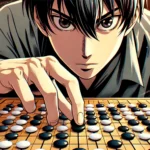The Best Fluffy Pancakes recipe you will fall in love with. Full of tips and tricks to help you make the best pancakes.
Introduction to the Ancient Game
Go, known as Weiqi(圍棋)in China and Baduk in Korea, is more than just a game—it’s an art, a form of ancient wisdom spread across East Asia for thousands of years. It is one of the oldest board games still played today, Go has a significant historical and cultural importance. Let’s dive into the fascinating evolution of Go, from its legendary beginnings in ancient China to its vibrant presence in the modern world.
The Origin of Go
The origins of Go stretch back more than 2,500 years to ancient China. According to myths, Emperor Yao created the game as a tool to teach his son, Dan Zhu, about discipline and strategic thinking. Other stories suggest that ancient Chinese generals used Go as a way to train soldiers in battlefield tactics. Some sources suggest that Zhuge Liang (諸葛亮 ), the most famous Chinese military leader also played this game. Regardless of its exact origin, by the Zhou Dynasty (1046–256 BC), Go had become a pastime of Chinese scholars, nobles, and emperors alike.
As the game evolved, Go became a symbol of wisdom, talent and self-discipline. Chinese philosophers saw Go as a reflection of the natural world, with the board symbolizing the universe and the stones, representing opposing forces in balance. There’s a saying “Life is like chess (人生如棋)”, in which chess is referred as Go in the Eastern culture. Go is a perfect metaphor for life because once you make a move, there’s no turning back, and you have to adjust your game plan accordingly to the changes in the world. The game’s emphasis on harmony and adaptability resonated with Confucian and Taoist values, making it a key element in traditional Chinese culture.
Go’s Journey in Japan and Asia
Go in Japan: A Game for the Samurai Go found its way to Japan in the 7th century, where it quickly gained popularity. During the Heian Period (794–1185 AD), the game captivated the Japanese aristocracy, and by the Edo Period (1603–1868), Go had become so respected that the Tokugawa shogunate established official “Go houses” to train players professionally. These Go houses, like the prestigious Honinbo school, produced some of history’s most famous Go masters, such as Honinbo Shusaku. Japanese Go culture emphasized formal training, ranking systems, and competitive play, leading to the development of many modern Go techniques.
Baduk in Korea: A National Treasure Korea embraced Go with equal fervor, renaming it Baduk and integrating it into Korean society. Baduk became a national pastime, with unique Korean strategies and play styles emerging over centuries. Today, Baduk is celebrated in Korea with national tournaments and government support, contributing to the country’s reputation for producing some of the world’s top Go players.
Go’s Global Spread in the 20th Century
Go began reaching the Western world in the early 20th century, thanks to travelers, scholars, and Japanese immigrants. In 1950, the American Go Association was founded, establishing a formal Go community in the United States. Similarly, Go associations in Europe sparked interest and competition throughout the continent. The rise of digital platforms in the 21st century, such as KGS and OGS, made Go accessible to millions worldwide, helping it gain popularity as an international phenomenon.
AI and Go: A New Chapter in History In 2016, Go’s strategic complexity faced a groundbreaking test with the advent of artificial intelligence. Google’s AlphaGo program defeated world champion Lee Sedol, marking a historic moment and showcasing AI’s remarkable capacity for strategic decision-making. This event ignited global fascination with Go and introduced a new generation to the game, expanding its community and advancing studies on both human and machine learning.
Cultural and Philosophical Significance
For centuries, Go has been one of the “Four Arts” of a cultured life in China, alongside music, calligraphy, and painting. Go’s rules and strategies mirror fundamental Eastern philosophies. The board represents the balance between yin and yang, where seemingly opposite forces coexist in harmony. Players learn to balance aggression and patience, valuing adaptability over strict adherence to rules. This philosophical depth makes Go more than a game—it’s a tool for self-reflection and personal growth.
Conclusion: Go in the Modern World
Today, Go’s appeal continues to grow, transcending borders and bridging cultures. With millions of players and a vibrant community worldwide, Go is celebrated not just for its strategic depth but for its power to connect people across languages, traditions, and beliefs. Whether you’re a new player or a seasoned competitor, Go offers a timeless challenge that sharpens the mind, deepens cultural appreciation, and invites you into a world of rich history and endless possibilities. If you want to learn more about this game, check out here for a quick tutorial




